Hveragerði 作者: 来源: 发布时间:2021-09-30
一、所属省或是州,具体位置,人口,面积
Hveragerði is a municipality in the western part of Árnessýsla, located under Kambar , just east of Hellisheiði . Urbanization began with the establishment of Mjólkurbús Ölfusingar which began operations in 1930, but Hveragerðishreppur was established out of Ölfushreppur in 1946 and received town rights in 1987. Hveragerdi is sometimes called the flower farm where the festival is held Flowering days. Varmá, which originates in Hengill, flows through the town.
It has a population of 2,699, and an area of 11.4 square kilometers. Hveragerði has experienced strong population growth in recent years (1997 to 2005: + 31%).
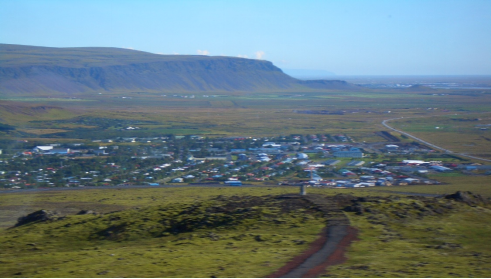
二、自然地理
1.地理条件
In the village itself there is a field with hot springs (Icelandic hver or hverin), as the area belongs to the system of the central volcano Grensdalur. In the middle of the village is a high temperature area below the church. In the gardens of some houses you can also see hot (steaming) and white areas. The earth's crust is very thin under white spots. On the northern outskirts is the small geyser Grýla.
There is also a hiking trail through a park or along a path across a stream to the north, passing numerous steaming spots and a hissing borehole.
Since the severe earthquake in May / June 2008, a new high-temperature area has developed at the foot of Mount Reykjafjall (in the east of the town). It is partly on the territory of the Agricultural College (formerly Garðyrkjuskóli). Actually, this is about the revitalization of an already cooled high temperature area.
2.交通情况
The bus runs between Reykjavík - Hveragerði and Selfoss every day of the week. The Strætó bus stop in Hveragerði is Orkun's petrol station (Shell hut) at Austurmörk.
Hveragerði is located 46.6 kilometers to the Southwest of Reykjavik, and can be reached by car directly via the National Ring Road 1.
https://www.hveragerdi.is/is/thjonusta/umhverfi-og-samgongur/almenningsamgongur
三、经济发展和规模
The annual accounts of Hveragerðisbær are prepared in accordance with the Local Government Act, the Act on Annual Accounts, regulations on accounting, budgets and annual accounts of municipalities and advertisements of the Ministry of Local Government on the accounts of municipalities.
The activities are divided into Part A on the one hand and Part B on the other. Part A (municipal fund) includes activities which is partly or wholly financed by tax revenue but in Part B there are companies which are partly or the majority are owned by the municipality and are run as financially independent units which are: Sewerage, Social apartments, and water supply. "
The municipality's operating income for the year amounted to ISK 3,013.7 million, according to summaries profit and loss account for parts A and B, but the budget provided for operating income of ISK 2,968.1 million. The operating income of Part A amounted to ISK 2,913.3 million, but the budget assumed operating income of ISK 2,870.5 million.
The operating result of the municipality according to the consolidated income statement of parts A and B was positive amounting to ISK 6.3 million, but according to the budget, ISK 50.2 million was assumed positive results. The operating result of Part A was negative in the amount of ISK 11.4 million over budget assumed a positive result of ISK 20.2 million. The municipality's equity at the end of the year amounted to 1,343.3 ISK million according to the balance sheet, of which equity A part amounted to ISK 1,064.8 million.
The ratio of regular income to total liabilities and commitments is 100.77% for Parts A and B, compared to 94.56% in 2018. The debt ratio for Part A is 101.08% but was 100.85% in 2018. According to Article 64 2. para. of the Local Government Act, this proportion should not exceed 150%.
The population of Hveragerðisbær on 1 January 2020 was 2699 and was an increase of 71 individuals from the previous year. "
https://www.veitur.is/utgefid-efni/vatnsveita
四、产业特点重点项目
Business development
The first attempt at a dry camp life in Hveragerði is related to the construction of a wool factory at Reykjafoss in Varmá in 1902. Water wheels and belt drive powered its machines and in 1906 a small water-powered power station was installed and the street to the main road at Ölfusréttir illuminated a year later, Iceland first street lighting. The Reykjafoss factory was operated until 1912 and in 1915 it was demolished except for the foundation that is still visible.
Samvinnufélag um Mjólkurbú Ölfusinga was founded in 1928, 45 ha of land was bought and the hot spring area was there. Mjólkurstöðvarhús was built in the summer of 1929 at Breiðumörk 26 and the same summer the first two residential houses were built, Varmahlíð and a summer house in Fagrahvammur where horticulture began in Hveragerði. Mjólkurbúið used geothermal energy from Bakkahver for its production as well as electricity from Varmárvirkjun, which was built in 1929 about 260m above Reykjafoss. The dairy farm was operated until 1938, but the houses still stand and are today, among other things, used by the Elementary School in Hveragerði.
The Icelandic state bought the land Reykir above Hveragerði in 1930 and operated a tuberculosis shelter there until 1938. A year later, the State Horticultural School began operations in Reykjavík and the first gardeners were graduated in the spring of 1941. Many of them and workers from Fagrahvammur built horticultural stations in Hveragerði. In Hveragerði, seven horticultural stations were operated in 1940 and had grown to twenty in 1950. Flower cultivation increased greatly in the 1950s. Residents of the Reykjavík area started visiting Hveragerði early to buy horticultural products. This is another special feature of the town, especially in early summer when buyers of summer flowers fill the streets. From that soil sprang, among others, Paul Michelsen's Blómaskáli, where the store Blómaborg and the horticultural station Eden, founded in 1958, which was one of the most visited tourist destinations in the country for years, is now. Eden burned to the ground on July 22, 2011.
Shopping began in Hveragerði in 1938. Kaupfélag Árnesinga started a retail business in Hveragerði in 1944 and ran a branch at Breiðumörk in Hveragerði for a long time in the building that now houses the vocational and visual arts teaching at Hveragerði Primary School. Sparisjóður Hveragerði og nágrennis began operations in 1962, but five years later Búnaðarbanki Íslands took over the savings bank and has operated a branch in Hveragerði ever since. Georg Michelsen started making bread in Hveragerði in 1946 and the company, Hverabakarí, at Heiðmörk 35 was operated for years
In 1950, Landspítalinn began operating clay baths in Hveragerði, and the Icelandic Society of Naturopathy began operating a health resort in 1955.
In 1952, the Árnessýsla County Council bought two houses for the elderly and negotiated with Gísli Sigurbjörnsson á Grund for their operation. It became the indicator for Dvalarheimilin Ás / Ásbyrgi.
The company Kjörís hf. was founded in 1969. The founders of the company were Gylfi and Bragi Hinrikssonir together with Hafstein, Guðmundur and Sigfús Kristinsson. The founders of Kjörís were Hafsteinn, a dairy technician, and Gylfi, a mechanical engineer. Kjörís' predecessor was Ostagerðin hf, which Hafsteinn ran for two years in Hveragerði from 1966.
The amusement park in Hveragerði started operating in 1986 in a 6,000 square meter building opposite Eden in Austurmörk. There were, among other things, caravans, haunted houses, a boat pond and a shooting range, as well as various entertainers who let their light shine at events in the Tivoli Gardens. The amusement park was hugely popular during the first years of operation, but with the advent of British traveling amusement park, which began to make its way to the country in the early 1990s, operational difficulties began to become apparent. The amusement park closed in the spring of 1994. That summer, a market square opened in the building, modeled on Kolaport, but Hveragerðisbær had then become the owner of the building. The old boat pond was used as a char fishing pond where you could slide for fish and pay for a bite. Before Christmas 1995, Christmasland opened in the house but became short-lived. Several districts in Rangárvallarsýsla merged to buy the house in 1998. The house was divided into three parts and used for the construction of a multi-purpose house in Þykkvabær, the meeting hall of the Pentecostal church at Kirkjulækjarkot in Fljótshlíð and a riding hall at Gaddstaðaflatur by Hella.
Various attempts to utilize geothermal energy in business operations characterize Hveragerði's business history and still use all greenhouses in the town as well as, for example, Kjörís geothermal energy for its operations.
五、风景名胜,景点( attractions)
1. Hveragarðurinn Hot Spring Area
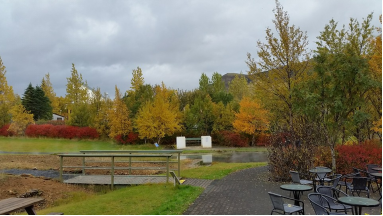
The hot spring area in Hveragerði is located in the middle of the town and is one of the most remarkable natural pearls of the South. Hveragerði is in the eastern edge of the eruptive belt that runs from Reykjanes via Þingvellir and north of Langjökull and the thermal area lies across this eruptive belt.
There is a reception for tourists in a cabin by Hveramörk, east of the hot spring area. There you can get a variety of information about the existence of geothermal energy, connections to microbiology, geology, cracks and volcanic activity. In addition, it explains how the utilization of geothermal energy takes place, reports on the depth of boreholes, the power obtained from them and how it is utilized.
There you can boil eggs and get hot rye bread. Visit the greenhouse and read about a rubbish bin with a fun story so you can go for a foot bath and a mud bath in the summer.
https://www.hveragerdi.is/is/mannlif/hvad-er-i-hvergerdi/hveragardurinn
2. Amusement Park Fossflöt
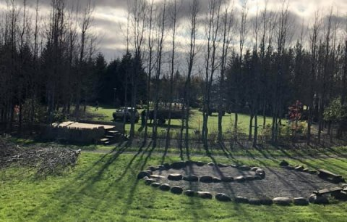
The amusement park is marked by Breiðumörk, Skólamörk and Varmá. The cultivation of the garden began there in 1983 and there is now beautiful vegetation with playgrounds, benches and tables that tourists can use for outdoor activities. Remains of an old house foundation can be seen on the bank of Varmár below Reykjafoss. The foundation marks the beginning of settlement in Hveragerði because there was a wool factory that was built in 1902 and used the fall energy of the waterfall. Inside Varmárgil, there are standing walls of a power station that was built in 1929. From there, the foundations of the drop shaft can be traced to the more complete dam below Hverahvammur.
A nice walking path runs along Varmán where you can see the old house foundation. The gorge has the most beautiful color combinations and hot springs that no one should miss.
https://www.hveragerdi.is/is/mannlif/hvad-er-i-hvergerdi/lystigardurinn-fossflot
3. Blómstrandi dagar Annual Flower Festival
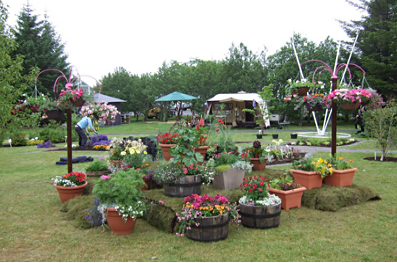
TheTown Festival, Blooming Days, in Hveragerði. Residents take an active part in the festival and the supply of cultural events has increased year by year as has the number of guests. Emphasis is placed on events from Thursday to Sunday, although the highlight of the festival is on Saturday. Interesting art exhibitions and various music events are in town these days as well as health-related events for all age groups.
The program is varied:
Marketplace, garage sales, art exhibitions and open workshops
Jónas Sig, 80s Nostalgia, Jón Jónsson and Ingó Veðurguð
Hljómlistarfélagið, Sætabrauðsdrengirnir and Harmonikkufestival Bassa
Vintage car show, the theater group Lotta, BMX brós and Diskótekið Dísa
The tipper, the aparólan and the Sprell amusement park
Flowering Days is a family, culture and health festival without alcohol and parents are encouraged to respect the leisure time of children and teenagers.
Residents contribute to the festival by decorating their neighborhood and garden. A great atmosphere has also developed around the garage market and galleries all over town.
Prizes will be awarded for the most beautiful, original and most beautiful decorations. The most beautiful street will also be chosen.
https://www.hveragerdi.is/is/mannlif/vidburdir/blomstrandi-dagar
六、历史文化
1.历史
Beginning of settlement
Village formation began in Hveragerði in 1929, Hveragerðishreppur was founded in 1946 and became a municipality in 1987.
Hveragerði was built in the land of Vorsabær in Ölfus, but the name was originally for the hot spring area in the town in the middle, south and west of the church. Hveragerði is first recorded in Fitjaannál vacant before 1700, where the displacement of a geyser in the earthquakes of 159 is described. Hveragerði is still relevant in 1844 when it was decided to transfer the legal rights of Ölfusingar from Hvammur to Borgarheiði by Hveragerði.
Rural Development
The population of Hveragerði increased slowly in the first decade and at the end of 1941 they were about 140. In the following years they increased rapidly and were about 400 at the end of 1946, the founding year of Hveragerðishreppur. In the following decades, the population increased much more slowly, from around 530 at the end of 1950, 685 at the end of 1960 and 740 at the end of 1970. In recent years, the increase has been more rapid, especially in the decade 1971-1980. The population was about 1245 at the end of 1980, 1600 at the end of 1992, 1813 at the end of 2000 and about 2,476 at the end of 2016.
Ölfushreppur built a parliament building in Hveragerði in 1930 at Breiðumörk 25. The restaurant was in Ölfushreppur parliament building from 1931 and there has been a hotel there more or less since 1947. Mjólkurbús Ölfusinga was also operated in the building. The building was designed by Guðjón Samúelsson, master builder, who designed many of the country's most famous buildings, such as Hallgrímskirkja and the National Theater. The house was designed by Guðjón Samúelsson, the master builder of the state. The first yoghurt produced in Iceland also came from the old skyr type and was sold under the name healthy milk. In 2016, skyrgerði started again in the building when the restaurant Skyrgerðin started operating.
With the enactment of the Education Act in 1907, school work began on behalf of the state. Schoolhouses were also built on Kotströnd and Hjalla in Ölfus. The school at Kotströnd soon moved to Sandhóll and when Þinghúsið was built in Hveragerði this year, schooling moved there. In 1937, a boarding school was established in Hveragerði when the house Egilsstaðir was bought, which had previously been the orphanage of the Oddfellow rule. In 1943 a school bus was bought and since then the school has been a homeschooling school. Árný Filippusdóttir built the house Hverabakki and ran a girls' school there 1936-56. In the autumn of 1947, the oldest part of the current main building was taken into use. In the autumn of 1972, the school was divided into two separate institutions, Barnaskólinn and Gagnfræðaskólinn in Hveragerði, and the school became two principals. When Gagnfræðaskólinn was founded in the autumn of 1965, the upper floor of the swimming pool in Laugaskarð was rented for three benches of Gagnfræðaskólinn. The first grade was in the elementary school building. In January 1973, all classes of the Gagnfræðaskólinn moved to rented premises at Breiðumörk 2. In 1988, an extension to the old primary school was taken into use and the school was reunited into one institution.
Ungmennafélag Ölfusinga was founded in 1934. Ungmennafélag Hveragerði og Ölfus started the scratch card lottery Ferðaþristinn at the end of 1987 and the proceeds were to go to the construction of sports facilities in Hveragerði. The cost of the lottery, however, was much higher than expected and sales were lower than expected. The difficult operation of the lottery led to UFHÖ being declared bankrupt in 1992 and is one of the few sports clubs in the country that have gone bankrupt. In the same year, more precisely on March 28, 1992, a new sports club was established in Hveragerði, Íþróttafélagið Hamar.
2. 文化体育
The use of the hot spring for boiling, baking, washing and central heating will have attracted many people to live in Hveragerði in the beginning. Food was cooked and bread baked in steam boxes by the hot spring or on the door of the house. Laundry was washed by the hot spring or in a heat exchanger by the house wall. The locals in Ölfus had long used the hot springs for washing and baked rye bread in warm soil by the hot springs, as the place name Brauðholur testifies. There were many summer cottages, especially during the war years. According to the real estate register from 1941, there were 37 residential buildings in Hveragerði and 19 holiday homes. The summer cottages were west of the hot spring area, mostly on the streets Laufskógar and Hverahlíð. In the founding year of Hveragerðishreppur in 1946, 91 apartments were registered there. But at the end of 2016, there were about 900 of them.
Geothermal utilization has always been the basis of local development. Residents used the heat for cooking, baking, washing and heating the house, and their accessibility paid their share in attracting people to live in the town. There were, however, examples of geothermal energy not being used for space heating at the beginning of the settlement, but then most people managed to create their own simple district heating system from the nearest nearby hot spring. The water was led home through pipes or logs to develop by the house wall. In the development, pot heaters and the water cycle were used to transfer heat to the heaters indoors.
Geothermal energy in Hveragerði was first utilized to some extent at Mjólkurbú Ölfusingar around 1930. In 1940, the first geothermal well was drilled and the steam was led to the greenhouse in Fagrahvammur. This hole was 54 m deep but has now disappeared.
七、其他信息
The 2008 earthquake in 2008 was actually two earthquakes that occurred almost simultaneously, or at three-second intervals, on 29 May at 15:45 and had a much greater effect in Hveragerði than the earthquakes of 2000, as it is much closer to the town. The magnitude of the quake was 6.3 magnitude. The first earthquake originated under Ingólfsfjall, but the second near the town of Krossi approx. 2km southeast of Hveragerði.
Asphalt on the highway one and more roads were uprooted, houses were badly damaged, personal belongings and furniture lay like raw wood all over the floors of many homes in Hveragerði and the surrounding area. Bottles in Vínbúðin in Hveragerði were blown to the floor and broken into flour so that alcohol flowed on the floor. A rock fall occurred on the slopes of Reykjafjall above Hveragerði as well as in Hamrin, and bumps rolled all the way down to the plain. Then cracks formed near the mountain edges of Reykjafjall.
A first aid station was opened in the primary school and then the police drove around the town with a gall horn and asked people to stay outside.
Geothermal activity shifted considerably, but the thermal area in the center of Hveragerði cooled considerably during the earthquake. On the other hand, strong growth moved to an area northwest of the State Horticultural School to Reykjavík, which had previously been rather slow.
八、联系方式
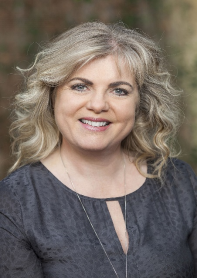
Mayor: Aldís Hafsteinsdóttir
Telephone: 483 4000
Email: aldis@hveragerdi.is
https://www.hveragerdi.is/is/stjornkerfi/baejarstjorn/baejarstjori
